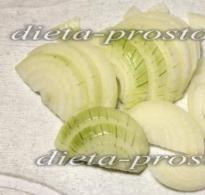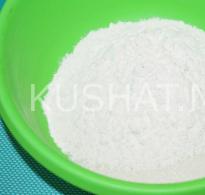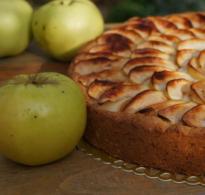"Golden orange" kumquat: its benefits for the human body, possible harm, norms and areas of application. The benefits and harms of kumquat, how it is eaten, what its taste looks like, recipes
No matter how they call this unusual fruit - and kinkan, and Japanese orange, and fabulous mandarin. Kumquat, which has gained immense popularity in many countries of the world due to its unique nutritional and taste qualities, in ancient times was the main food used by Japanese and Chinese sages. Useful properties of kumquat are contained not only in the fruit itself, but also in its peel. This unique fruit should only be eaten whole. The fruits of this amazing fruit have a fiery orange hue, an unusual aroma and an unforgettable taste that can be both rich sweet and sour.
Benefit
The appearance of the kumquat is somewhat reminiscent of an orange familiar to the domestic consumer. Is that the shape of the kumquat is not round, but oval. The size of the fruit is somewhat more modest: the average fruit is no more than five centimeters long, and about four in diameter. The taste of this exotic citrus product is reminiscent of the taste of mandarin. The aftertaste is slightly sour.
The fruits of kumquat contain a large amount of fiber, as well as pectin and natural enzymes. Due to this, this product is often used to normalize the functioning of the gastrointestinal tract. The benefit of kumquat lies in the fact that it is used as a prophylactic agent in case of the risk of developing a stomach ulcer or gastritis.
The beneficial effect of kumquat on the human nervous system is noted. It is believed that if a person prone to depression includes this fruit in his diet, then his nervousness and irritability will decrease, and the risk of chronic stress will come to naught.
The biochemical composition of this citrus product contains ascorbic acid. According to nutritionists, its amount in kumquat is much higher than in lemons.
The benefits of kumquat in the fight against fungus and other pests are undoubted. Due to the presence of furakumarin in the composition, this fruit has antibacterial and antifungal properties. Kumquat also contributes to:
- Increasing emotional sensitivity.
- Stopping apathy.
- Activation of mental activity.
In the old days, it was believed that this fruit contributes to the active stimulation of mental activity. That is why the kumquat was called the "fruit of the wise."
In oriental medicine, there are many recipes using dried kumquat peel. It is commonly used to treat:
- SARS and ARI.
- Flu.
- Cough.
- Runny nose.
To combat these infectious pathologies, inhalations are carried out two or three times a day. Thanks to this, essential oils are quickly released and easily absorbed by the oral mucosa.
Japanese orange is a dietary product. It provokes the excretion of cholesterol (harmful) from the body and cleanses of heavy metals and toxins.
Due to the fact that kumquat accompanies the cleansing of blood vessels from fatty plaques, it is considered an excellent prophylactic for the risk of developing atherosclerosis, heart attack or stroke.
"Fairytale Mandarin" has a soft, rich and unusual taste, almost unparalleled. It is customary to eat it completely, along with the peel. This ensures the maximum benefit of the product, because heat treatment, even the most delicate one, "kills" the important ingredients of its composition. Some connoisseurs generally prefer the peel alone. And kumquat juice works great with ginger root.
As in the raw product, the beneficial properties of dried kumquat are preserved both in the pulp and in the skin. In dried form, this exotic fruit is used both in cooking and for medicinal purposes. In addition, dried "dwarf orange" helps to normalize digestion. The dried peel of the product is an effective weapon in the fight against viruses. Therefore, in the off-season, it is recommended not only to actively consume the product, but also to spread the peel on home windowsills.
Dried kumquat fruits are used for the preparation of alcoholic beverages, cocktails and all kinds of tinctures. In bohemian restaurants in Europe, "dwarf orange" is served as an appetizer for expensive alcoholic drinks.
Often, kumquat is added to snacks, sauces and salads, it is used to prepare fish, meat dishes and delicious desserts. Quite common and dried kumquat.
Japanese orange goes well with turkey meat, which is also considered a dietary product. Practical English people bake delicious brioches with milk and orange juice for the holidays. Kumquat marmalade has a rather interesting taste. It does not require a lot of time and ingredients to prepare.
This citrus product is great for preparing a tincture that reduces the level of bad cholesterol, has a beneficial effect on the state of the heart and vascular systems, and is an excellent prophylactic for the risk of developing heart pathologies.
One of the interesting properties of kumquat is that it effectively relieves a person from a hangover. In Asian countries, after the holidays and heavy drinking, many fans of noisy parties still restore their health with the help of these fruits.
Japanese orange is an exotic fruit. When purchasing it, it is important to pay attention to its appearance. The hue of the peel of the fruit should be bright orange. The kumquat must be smooth to the touch. Mechanical damage, cracks, dents and other "marriage" are not in his favor. The softness of the fruit should be moderate.
Kumquat is capricious. It must be stored exclusively in the refrigerator for twenty-one days. Before sending the purchased product to the refrigerator, it must be thoroughly washed and dried with a paper towel. Not a single wet droplet should remain on the skin.
In the freezer, the fruit can retain its amazing properties until the expiration of the six-month period.
Harm
- bearing a fetus;
- lactation;
- propensity to develop an allergic reaction.
calories
This exotic product is dietary. The calorie content of kumquat is low, but if the fruit is abused, both raw and dried, the risk of obesity increases. This is due to the high content of carbohydrates.
Contraindications
The negative properties of Japanese orange appear only in case of individual intolerance to citrus fruits. If a person is not prone to allergic reactions, kumquat does not pose any danger.
The nutritional value
Vitamins and minerals
The Japanese orange contains a huge amount of minerals and vitamins of groups B and C. In addition, this unique fruit contains essential oils and fatty acids. Due to the high concentration of vitamin C in the fruits of an exotic delicacy, it is an excellent means of strengthening the immune system.
| Vitamin | Content (mg) | %Daily Value |
| A | 15 | 1,7 |
| B1 (thiamine) | 0,037 | 2,5 |
| B2 (riboflavin) | 0,09 | 5 |
| B5 (pantothenic) | 0,208 | 4,2 |
| B6 (pyridoxine) | 0,036 | 1,8 |
| B9 (folic) | 17 | 4,3 |
| C (ascorbic acid) | 43,9 | 48,8 |
| E (TE) | 0,15 | 1 |
| PP (Niacinth equivalent) | 0,429 | 2,1 |
| Choline | 8,4 | 1,7 |
| Mineral | Content (mg) | %Daily Value |
| Calcium | 62 | 6,2 |
| Magnesium | 20 | 5 |
| Sodium | 10 | 0,8 |
| Potassium | 186 | 7,4 |
| Phosphorus | 19 | 2,4 |
| Iron | 0,86 | 4,8 |
| Zinc | 0,17 | 1,4 |
| Copper | 95 | 9,5 |
| Manganese | 0,135 | 5 |
Kumquat is a healthy and tasty fruit. Add it to your diet, and the body will be enriched with many vitamins and minerals, and the immune system will become much stronger.
Of the citrus fruits, the kumquat stands out. It is hard not to notice it and it is simply impossible to pass by. It is bright, juicy, tasty and also very healthy. Unlike many other representatives of this family, this product is consumed together with the peel, which has a pleasant slightly tart taste.
Fabulous tangerine, Japanese orange, food of the sages - these are all the nicknames that the delicious and fragrant kumquat has won.
Description of the miracle fruit
The kumquat is a citrus fruit that is small in size and shaped like a walnut. But not only its appearance is considered atypical for this family. The uniqueness of this product lies in the fact that its peel is no less valuable than the pulp, so this fruit is eaten whole without removing the skin.
The taste of kumquat pulp is somewhat sour, somewhat similar to tangerine. And its soft peel is quite thin and sweet with a slight tart flavor.
Beneficial features
This fruit contains a long vitamin range, minerals and pectins. It is thanks to them that kumquat shows its beneficial properties:
- strengthens the immune system;
- increases the body's resistance to diseases;
- relieves the symptoms of a cold;
- exhibits bactericidal and antifungal properties;
- reduces the intensity of inflammatory processes;
- improves the functioning of the digestive system;
- is the prevention of peptic ulcers;
- protects against stress;
- relieves depression;
- raises the tone of the body;
- helps to get rid of apathy;
- regulates cholesterol levels.
Dried fruits
Dried kumquat also has beneficial properties and at the same time they appear much more intensely. In this form, this fruit has a fairly powerful antibacterial effect and helps the body resist viral infections.
On a note! Dried kumquat is not only eaten to quickly recover from colds, but also laid out around the house. In this case, it is the peel that works well, which is placed near an open fire!
The calorie content of dried Japanese orange fruits is small and amounts to no more than 71 kcal. For this reason, it can be used as a dietary supplement, enriching salads, main courses and low-calorie desserts with it.
Dried fruits
Dried kumquat exhibits the same beneficial properties as a fresh product. But fruits that have been processed in a dehydrator or have been in direct sunlight for a long time have the greatest value.
On a note! If the kumquat was first boiled in sugar syrup and only then dried under the sun, then the finished product can only be considered a delicious dessert. There will be no useful qualities in it!
The unpresentable appearance of dried fruits borders on their great value. Dark shriveled fruits will be useful for:
- retinal diseases;
- skin rashes;
- constant exposure to ultraviolet light.
How to use kumquat?
We got acquainted with the useful properties of kumquat, now we should understand how it is eaten. As mentioned above, it is customary to consume this fruit as a whole - along with the peel. At the same time, it is desirable to cut it into small slices.
On a note! When buying, remember that the peel of some varieties, such as the Hong Kong kumquat, can be very acidic, so remove it before use!
As a rule, it is customary to use only sweet varieties in their raw form, but sour ones are not left unattended. Very tasty desserts are obtained from such a fruit: jam, candied fruit, jam, marmalade, etc. These varieties can be preserved, added to sauces that are perfect for meat and fish dishes.
Contraindications
In most cases, kumquat brings great benefits to the body, and it is harmful only with individual intolerance. It is also highly recommended not to consume this fruit in unlimited quantities - 5-6 fruits eaten in the morning will provide the body with all the necessary substances.
In addition, the dried product is contraindicated in kidney diseases and high acidity. During pregnancy and with a tendency to allergies, the use of such fruits should also be discarded.
Kumquat jam
And finally, we suggest that you familiarize yourself with the kumquat jam recipe, which can take one of the first places on your homemade shelf.
To prepare a fragrant dessert, you will need:
- kumquat fruits - 1 kg;
- sugar - 1 kg;
- water - 1 l.
Cooking process.
- Wash the fruit and cut into thin slices, while choosing the bones.
- Collect the seeds, put them in a gauze bag and wrap the tip with thread.
- Place the kumquat slices in a saucepan and cover with water.
- Tie a bag of seeds with a thread in the handle of the lid and also lower it into the pan.
- Bring the contents to a boil, reduce the gas supply and cook for 25 minutes.
- Check the fruit for readiness and if they are too hard, then cook for about 10 minutes more.
- When the fruits are softened enough, the seed bag must be removed and sugar added.
- Stir the future jam and wait until the sugar is completely dissolved.
- Bring the mixture to a boil, cover and simmer for about half an hour.
- Check the jam for readiness: drop a small amount of it on a saucer and send it to the freezer for a minute - if the surface is wrinkled, then the dessert is ready.
- The pan should be removed from the stove and left for 5 minutes. After that, pour the jam into jars and roll up.
The benefits of kumquat cannot be overestimated. It is good fresh, dried and processed. Do not forget to include this product in your diet and it will definitely decorate your menu. Be healthy!
The kumquat is a small tropical fruit about the size of a walnut. The product is used together with the peel and has a sweet-tart taste. It is widely used in cooking for preparing sauces for vegetable and meat dishes, as well as in its raw form for decorating salads and various buffet snacks.
Among other things, kumquat has medicinal properties, as it contains many vitamins and minerals. In folk medicine, this fruit is considered one of the most effective products for fungal infections, colds, and also for getting rid of a hangover.
Kumquat: useful properties
Useful properties of kumquat can be described for a very long time, but first you should get acquainted with the composition of the product. The calorie content of the fruit is 71 kcal, it contains about 1.88 g of protein, 0.85 g of fat and more than 9 g of carbohydrates.
Kumquat contains a sufficient amount of vitamins A, B, E and C, as well as minerals (iron, phosphorus, sodium, zinc), pectin substances.
What are the benefits of kumquat?
- Replenishes the mineral reserve of the body, which helps to strengthen the immune system and improve the overall health of a person.
- Able to cure fungal diseases.
- It is widely used for the prevention and treatment of colds.
- It normalizes the metabolism in the body, which makes this fruit very useful for weight loss. There are even special diets based on this product that allow you to lose extra pounds.
- Is kumquat useful for the normalization of the gastrointestinal tract? And here the answer is positive, because the content of a large amount of fiber, pectin and other substances makes itself felt.
- Removes toxins, toxins, cholesterol, heavy metals from the body. This contributes not only to weight loss, but also to the restoration of good health.
Kumquat: The beneficial properties of this product cannot be overestimated, because it is one of the most effective dietary products that are used to treat and prevent many diseases.
Kumquat: contraindications
Despite the original taste properties of the product, there are still contraindications for kumquat. Not everyone can eat this fruit. For example, its consumption should be limited to people with diabetes who follow a special diet to lower blood glucose levels.
Harm from kumquat can be in the following cases:
- With increased acidity of the stomach.
- With kidney disease, as the product can cause a sharp exacerbation of the disease.
- With individual intolerance to the product.
- People with allergies should check for themselves how the use of kumquat will affect their body.
Now you know literally everything about the beneficial properties of the fruit, why kumquat is harmful, and also who should limit the amount of its consumption. It remains to consider the actual question of how this product helps with weight loss.
Kumquat and weight loss
Kumquat for weight loss is important because it is a low-calorie product. Thanks to this, the fruit can be included in a variety of diets that are designed for weight loss.
Kumquat should be consumed and cooked from it in whole dishes, without removing the peel. Thinly sliced peels make delicious additions to various dishes, and a drink can be prepared from the pulp.
Weight loss occurs due to the unique properties of the fruit:
- Improves the metabolic process in the body.
- Harmful substances and excess liquid are removed.
- After eating kumquat-based dishes, you do not feel hungry, which will allow you to refrain from eating excess food.
You can lose weight with kumquat in a few weeks. To do this, you will have to give up flour, sweet and fatty foods. Include dishes with the addition of this product in your diet, and you will lose 4-5 kg in the first week.
How to lose weight with kumquat?
- Add the product to salads, meat and fish dishes.
- Sauces are prepared from the pulp of the fruit, which are seasoned with all kinds of dishes.
- Use the kumquat as a snack with unsweetened drinks.
- You can make fresh juice from the fruit, which quenches thirst well.
Methods and scope of application of kumquat
- Take 15 kumquats, wash them, prick them with a toothpick and put them in a sterilized jar. Pour 1 cup of wine vinegar into a saucepan, add 4 boxes of cardamom, a pinch of salt. Pour hot marinade over kumquat and leave for 2 days. After that, the dish is ready, dry the kumquats with spices and you can eat.
- Kumquat salad. Take 200-250 g of kumquats, cut them into small circles. Add onions, lemon juice, salt, herbs, olives to taste to the salad. Use olive oil and pepper as a dressing. It turns out a delicious dietary salad that can be eaten for dinner, giving up indigestible foods.
Kumquat during pregnancy

Can kumquat be pregnant? It is worth analyzing this issue in more detail, as it interests many expectant mothers. First of all, what are the benefits of fruit for pregnant women?
- The product has antifungal properties, thanks to which it protects the body of the expectant mother.
- Prevents the development of varicose veins.
- The presence of fiber helps to avoid constipation.
- It has a detoxifying effect, which helps to cleanse the body of a pregnant woman from toxins and toxins.
However, kumquat during pregnancy can also be harmful:
- Abuse of the product during pregnancy is contraindicated.
- Particular care should be taken if the woman has diabetes or gestational diabetes.
- In the second half of pregnancy, the amount of product consumed should be minimized.
In general, kumquat during pregnancy is a valuable product that is recommended for consumption in moderation even by nutritionists, which means that you should not worry about your health.
Unfamiliar wonderful acquaintances, this is how you can call citrus fruits that relatively recently appeared on the shelves - kumquat (other names for fruits: kinkan, nagami, meiva). What will kumquat give a person, the benefits and harms from it, what prevails?
How is it eaten, is it possible to give fruit dishes to babies without fear for their health?
Do not be tormented by doubts, kumquat fruits are very useful for the soul and body of a person of any age: they improve brain activity, enrich the body with natural vitamins and mineral elements. Contribute to the prolongation of life and youth, as antioxidants, kumquat provide a person with remarkable immune protection.
Plant phytoncides, fruit hormones are uniquely powerful antidepressants, get rid of pathogenic microorganisms, poisons of chemical, radioactive, biological origin. Useful for the small, the old, the sick, the healthy.
What does a kumquat look like?
Medium-sized bright fruits resemble orange tangerines, yellow, golden oranges. They are also very variable in size: from a large grape to 5 cm in diameter. May differ in shape: round, oblong oval, slightly flattened. This is due to the methods of propagation of the tree and the varietal species of the plant.
What does a commercially mature kumquat look like?
Ripe fruits are fragrant, soft, elastic, juicy. The skin is bright with a lively luster. The taste is pleasant with sourness, the peel is edible sweet, or with a slight piquant astringency. Unripe fruits are hard, the surface is dull, pale shades. Do not buy overripe fruits. The kuvquat falling apart in the hands has almost completely lost its useful properties.
nutritional value
Fruits are famous for their remarkable nutritional properties:
- rich in vitamins C, A, E, group B,;
- multijuicy (juice, living water -80%);
- contain easily digestible natural carbohydrates;
- fragrant, due to the large number of useful esters;
- useful dietary properties: kumquat calorie content is only 56-76 kcal (100 gr.).
It is believed that 1-2 fruits instantly increase the ability of thinking, sharpness of mind, especially after a long festive feast, replete with alcohol-containing drinks.
Healing abilities
Fresh, from the kumquat tree is especially beneficial for health, how is it eaten? It is best with the peel, which, like the pulp, has exceptional medicinal properties:
Kumquat, useful properties: a natural remedy for numerous infections caused by pathogenic microflora, significantly improves immunity, actively removes toxins of various nature from cells. However, it has contraindications similar to the use of any citrus fruit: you can not eat fresh fruits with allergies, gastritis, gastrointestinal ulcers. They should not be consumed on an empty stomach.
Dried fruits
Dried candied kumquat has practically no contraindications, its beneficial properties are also valuable for health, like fruits barely removed from a tree: an excellent source of multivitamins, minerals, and medicinal substances.
This is a powerful anti-inflammatory agent, due to the presence of natural elements that destroy viruses, bacteria, fungi, helminths.
It is recommended to use for colds, tonsillitis, flu, acute respiratory infections,.
Remarkably cleans the mucous membranes of the oral cavity from the pathogenic environment in case of stomatitis, gingivitis, periodontal diseases.
Regulates the vital activity of beneficial microorganisms: activates digestive abilities, removes toxic substances, does not contain nitrites, nitrates.
It activates the choleretic process, causes the cleansing of the liver from congestion.
Stabilizes the work of nerve cells.
Gives vivacity, energy, thanks to the reserves of healthy sugars.
With caution, you need to eat it only with a tendency to allergies and impaired carbohydrate metabolism.
The calorie content of dried kumquat is 70-80 kcal.
Diversify the menu
What delicious dishes can be cooked with kumquat?
Any, pleasant aroma, spicy taste will decorate every dish:
- fruit, meat, fish salads;
- drinks - cocktails, compotes, smoothies, jelly;
- appetizers for the second courses of pickled, pickled kumquat;
- muffins, cakes, pies with candied fruits.
For the most refined taste. Eat for health!
And if you decorate the window sills of the kitchen, rooms with elegant plants in pots, the apartment will have an eternal blooming white-pink spring and a wonderful golden-orange autumn full of fruits. Not only is it very beautiful, but pleasant aromas of the lightest citrus freshness will constantly blow in the air space.
Kumquat is a delicious and fragrant tropical fruit. It is quite rare on store shelves, unlike tangerines, oranges and other citrus fruits. Due to the vitamin composition, its fruits are very useful for the body.
Before you buy a kumquat, you need to know about its benefits and harms to the human body. This article will reveal all the secrets of the "fruit of the wise men", talk about its healing properties and harm to the body.
Description of the fruit
Kumquat belongs to the citrus family. The fruits themselves are similar to oranges, but have an oblong shape. Fruits are small in size, their length reaches 4-5 cm, and their width is 3.5-4 cm. The flesh is slightly sour, but the skin is sweetish-tart.

It is widely used for medicinal and culinary purposes. Citrus is dried, pickled or preserved, used to make jams, jams, compotes or other delicacies.
Important! Kumquats are eaten whole without peeling.
Vitamin composition of kumquat
The fruits of kumquat are credited with healing properties. They are full of vitamins, micro and macro elements, essential oils and pectins.
The composition of the fruits includes vitamins: A, groups B, C, E and P. Among the minerals, one can distinguish: calcium, potassium, zinc, copper, phosphorus and sodium.
Beneficial features
Miniature tropical fruits are widely used to treat various diseases. Essential oils, which are part of the fruit, help:
- raise and strengthen immunity;
- protect the human body from viral infections;
- fight various fungal diseases;
- protect humans from bacteria.

Moreover, kumquat fruits improve the functioning of the gastrointestinal tract, improve metabolism throughout the body, and help to eliminate toxins and toxins, which is especially important after suffering poisoning.
Do not forget about the vitamin and mineral composition of the fruit. He helps:
- stop the development of arthritis and arthrosis, which disturb the joints;
- prevent the appearance of cancerous tumors;
- contributes to the improvement of well-being;
- normalizes pressure;
- improves overall well-being;
- calms the nerves;
- counteracts the onset of diabetes.
Important! The fruits of kumquat are very useful during the diet. They fill the body with vitamins that are needed during this period, contribute to the rapid breakdown of fats, and help to actively lose weight.
Harm to the human body
In addition to benefits, kumquat can also bring harm. Doctors do not recommend eating its fruits during pregnancy and lactation. They can cause severe allergies in infants.

Citrus should also not be used by people with individual intolerance to active substances, as well as with problems with the stomach (high acidity) or kidneys.
The healing properties of tropical fruit have been tested by more than one generation of people. Try the kumquat, and you will be able to evaluate its effect from personal experience.
What is kumquat: video
Kumquat properties: photo
















